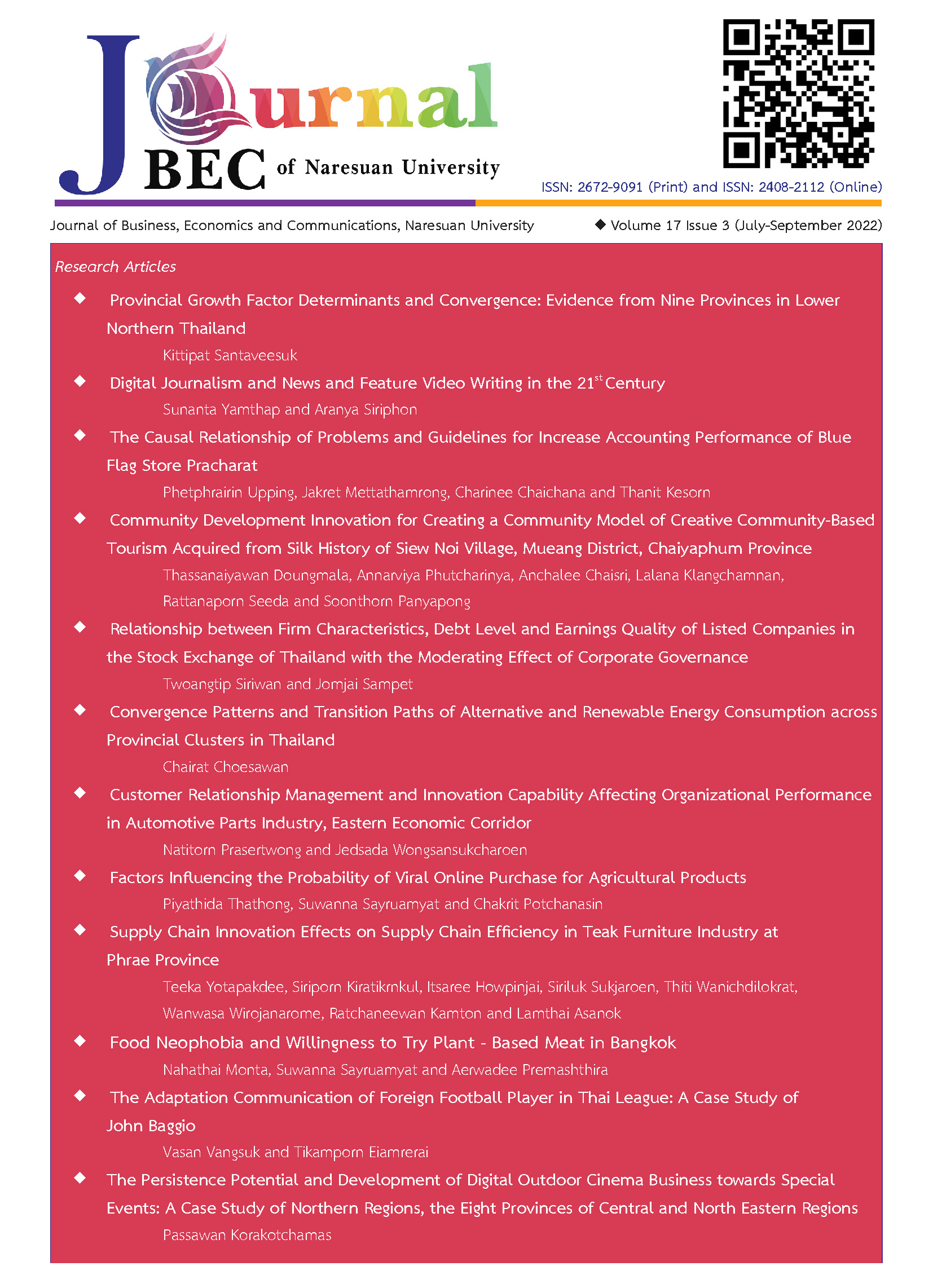Community Development Innovation for Creating a Community Model of Creative Community-Based Tourism Acquired from Silk History of Siew Noi Village, Mueang District, Chaiyaphum Province
Main Article Content
Abstract
The objectives of this research were (1) to study community potential development for creating a community model of creative community-based tourism acquired from silk history of Seaw Noi Village in Chaiyaphum Province; and (2) to construct a community development innovation for creating a community model of creative community-based tourism acquired from silk history of Seaw Noi Village, Chaiyaphum. Qualitative methods were employed in this research using Criteria for Thailand’s Community-Based Tourism Development and focus group discussion as a tool. Ten participants participated in the focus group discussion to brainstorm ideas on a community development innovation for creating creative community-based tourism community model acquired from silk history of Seaw Noi Village in Chaiyaphum. The qualitative data were analyzed by descriptive analysis.
The research results were as follows. (1) The overall community potential for creating a community model of creative community-based tourism acquired from silk history of Seaw Noi Village in Chaiyaphum Province was at a fair level. (2) The community development innovation for creating a community model of creative community-based tourism acquired from silk history of Seaw Noi Village, Mueang District, Chaiyaphum Province was 4As, namely Auditing, Awareness, Adjustment and Assessment.
Article Details

This work is licensed under a Creative Commons Attribution-NonCommercial-NoDerivatives 4.0 International License.
References
Amornpech, P. (2014). The human resource potential development for sustainable community tourism management of Chiang Mai local community phase 2. Chiang Mai: Faculty of Management Sciences Chiangmai Rajabhat University.
Banchongsiri, S., Kiaowan, B., Mungjongklangkul, K., Krandee, P., Angkul, S., Thongdeenok, S., et al. (2013). Community based agro-tourism network development in the lower north eastern region of Thailand. Retrieved November 20, 2020, from https://dric.nrct.go.th/Search/SearchDetail/297024
Chairach, P. (2017). Innovation role of standard on innovation. Retrieved November 20, 2020, from https://www.slideshare.net/PunArjChairatana/innovation-role-of-standard-on-innovation-20170727
Charnnarong, N. (2016). Culture supports tourism. Ramkhamhaeng Journal Humanities Edition, 35(2), 171 – 184.
Cheablam, O. (2009). Forest situations toward tourism in Ban Don Bay and offshore islands in Surat Thani province. Sukhothai Thammathirat Open University Journal, 22(1), 39-53. Chuen-upakarnun, T. (2006). Sustainable management guidelines for historical tourism in Lopburi old town. Bangkok: Chulalongkorn University.
Committee of National Tourism Policy. (2016). The criteria for Thailand's community-based tourism development. Bangkok: Committee of National Tourism Policy.
Dachum, P. (2013). Creative tourism development: from concepts to practise for Thailand. Silpakorn University Journal, 33(2), 331 – 366.
Doungmala, T., Phatcharinya, A., Chaisri, A., Klangchumnan, L., Seeda, R. and Punyaphong, S. (2018). Innovation model of creative tourism route management with participation of Chaiyaphum province. Journal of Research and Development Institute, Rajabhat Maha Sarakham University, 5(1), 155 – 170.
Inkumg, R. (2014). Measuring service quality of tourism information center at Suvarnabhumi airport. Journal of International and Thai Tourism, 10(1), 59 – 71.
Jangjaicharoen, P. (2015). Cultural tourism management; A case study of ogimachi community, Shirakawa-Go village, Gifu prefecture, Japan. A Thesis Submitted in Partial Fulfillment of The Requirements for The Degree of Master of Arts Japanese Studies Program, Department of Japanese Faculty of Liberal Arts Thammasat University.
Jinachampa, Y. and Sawarom, S. (2017). Development of community self-management model: The case of Chompoo sub-district Sarapee sistrict, Chiang Mai province. Journal of Graduate Research, 6(1), 183 – 197.
Kaewsanga, P. and Jumnongsri, N. (2012). Creative Tourism: A new choice of Thai tourism. Suranaree Journal, 6(1), 91 – 109.
Khongthong, P. and Meesawatdikul, W. (2019). Guidelines of tourism safety management of Hua-Hin, Prachuap Khiri Khan as tourist destination for foreign. Dusit Thani college Journal, 13(1), 403 – 414.
Modmontin, S. (2019). Community-based tourism to sustainable. Bangkok: GSB Research.
Muangyai, A. (2016). Development approach to enhancing the potential of community and local in the twenty-first century. EAU Heritage Journal Social Science and Humanities, 6(3), 12-26.
Pakdeeinit, P. (2010). The potentiality of community tourism interpretation: Rong Hai community Phayao province. Naresuan University Journal, 18(2), 82 – 90.
Phanichakul, P. (2010). Domestic tourist satisfaction towards the information service, north region office at tourism authority of Thailand. Master of Science Degree in Recreation Management, Srinakharinwirot University.
Phengkona, J., Maichon, R., Ruksapon, A., Na-thongkaew, B., Pongpranich, N., Thongsong, C., et al. (2015). Guidelines on community-based tourism management curriculum development for strengthening Chumphon community-based tourism network. Chumphon: Maejo University.
Prajonsant, S. (2016). Potential development of personnel in tourism handbook. Bangkok: Department of Tourism.
Richards, G. and Raymond, C. (2000). Creative tourism. ATLAS News, 23, 16-20
Rungphiphattanapong, S. (2015). The case study of Amphawa commuity, Samutsongkarm province. Journal of Liberal Arts, Ubon Ratchathani University, 11(2), 115-140.
Sangsanit, N. (2016). Creative tourism. Retrieved November 28, 2020, from https://creativetourism.weebly.com/
Smith, David. (2006). Exploring innovation. Berkshire: McGraw-Hill Education.
Sukpet, K. and Frenzel, S. (January 27-29, 2011). The managing natural resources in the community: Concept through development of natural tourist route Ban Wiang Haeng, Chiang Mai Province. In The Eleventh National Conference on Sustainable Community Development “Future Community Foundation for Sustainable Development” (pp. 199-203). Khon Kaen: Khon Kaen University.
Teparakul, A. (2012). Creating and maintaining community sustainability through creative tourism: The case of Thailand. Retrieved December 27, 2020, from http://www.dasta.or.th
Thangchan, W. (2016). Potential development of personnel in tourism handbook. Bangkok: Department of Tourism.
Thongpronwanich, S. (2011). CBT. Bangkok: The Thailand Research Fund.
Thumwicha, W. (2016). Potential development of personnel in tourism handbook. Bangkok: Department of Tourism.
Wichaidit, T. (2020). New normal tourism. Retrieved November 28, 2020, from https://www.77kaoded.com/news/lakana/1753843
Huibin, X. and Marzuki, A. (2013). Community participation of cultural heritage tourism from innovation system perspective. International Journal of Services Technology and Management, 18(3-4), 105-127.


